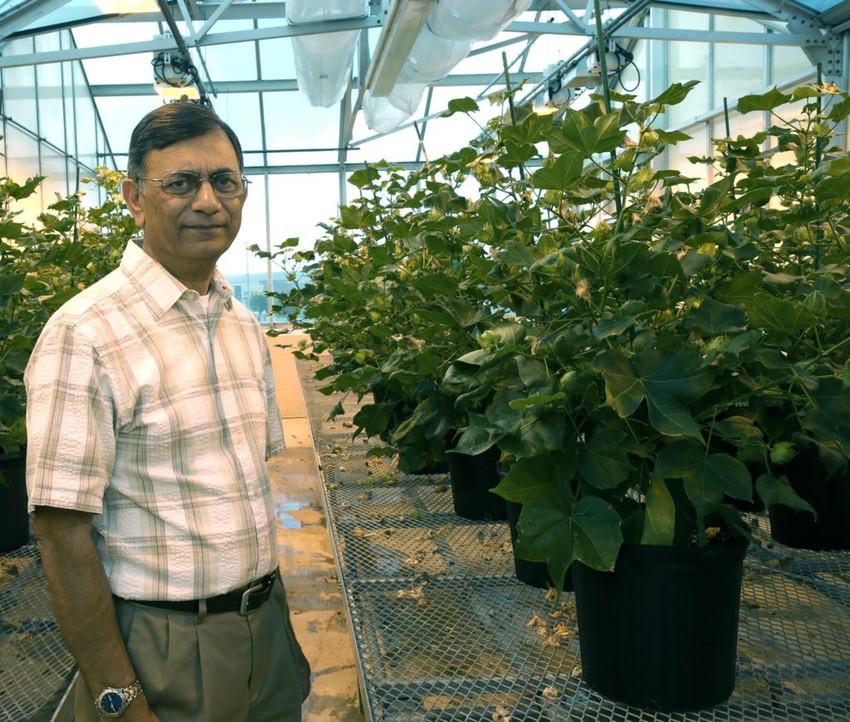With gossypol no longer a deterrent, protein-rich cottonseed has potential use in human food plus aquaculture and poultry feeds.
October 14, 2019

The U.S. Food & Drug Administration has given the green light to ultra-low-gossypol cottonseed (ULGCS) to be utilized as human food and in animal feed -- something Texas A&M AgriLife researchers have been working on for nearly 25 years, according to an announcement.
Dr. Keerti Rathore, a Texas A&M AgriLife Research plant biotechnologist in the Texas A&M Institute for Plant Genomics & Biotechnology and the department of soil and crop sciences, and his team have developed, tested and obtained deregulation for the transgenic cotton plant TAM66274.
TAM66274 is a unique cotton plant with ultra-low gossypol levels in the seed, which makes the protein from the seeds safe to consume but also maintains normal plant-protecting gossypol levels in the rest of the plant, making it ideal for the traditional cotton farmer, Rathore said.
If adopted by the cotton growers worldwide, ULGCS has the potential to make a significant impact on nutrition security, especially in the poor, cotton-growing countries, Rathore added.
“The amount of protein locked up in the annual output of cottonseed worldwide is about 10.8 trillion grams,” he said. “That is more than what is present in all the chicken eggs produced globally and enough to meet the basic protein requirements of over 500 million people.”
Except for a few countries, most cotton-producing countries, particularly in Asia and Africa, suffer from hunger and malnutrition, Rathore said. Up until now, the ability to utilize protein-rich cottonseed for food or even as feed for non-ruminants was not possible because of the presence of gossypol, which is a toxic terpenoid.
With the development and approval of the ULGCS, gossypol is no longer a deterrent.
According to AgriLife Research, when used in animal food, the appropriate name for dehulled cottonseed derived from TAM66274 cotton is “low-gossypol dehulled cottonseed,” and the appropriate name for dehulled cottonseed meal derived from TAM66274 cotton is “low-gossypol dehulled cottonseed meal.”
Rathore said initially low-gossypol cottonseed protein can be used by two of the most efficient systems to convert feed protein into edible animal protein: aquaculture and the poultry industry. “Both of these industries are experiencing high rates of growth and are likely to continue growing for the foreseeable future,” he said.
Getting to this point took approval from two areas of government. First, non-regulated status for TAM66274 was required by the U.S. Department of Agriculture’s Animal & Plant Health Inspection Service. Then, FDA approval was needed.
“This approval from FDA enables cultivation and use of this promising new cottonseed product within the U.S.,” Rathore said.
The research was supported by funds from Cotton Inc. and AgriLife Research.
Dr. Kater Hake, vice president of agricultural and environmental research at Cotton Inc., said gossypol suppression in cottonseed has been part of the company's funded research portfolio for more than 30 years.
“It took time to tap the innate protein potential in the seed, time for the right technologies to develop and time for the right research team to come along,” Hake said.
The next step, Hake said, is to get cotton farmers and the industry around the world to begin growing and marketing the special variety.
Tom Wedegaertner, director of cottonseed research and marketing at Cotton Inc., explained that gossypol in the leaves and stalks of the cotton plant serve as a pest deterrent, but its presence in the seed serves no purpose.
“The more widespread use of cottonseed as a livestock feed and even for human consumption has been stymied by the natural levels of gossypol in the seed,” Wedegaertner said. “Now, we have the ability to utilize the protein.”
Hake said with the full deregulation approval in place, “We can now demonstrate the value of a novel food source to cottonseed processors and seed companies who are essential to purchasing and delivering the seed to cotton growers.”
With expanded use of ULGCS for human nutrition either directly as food or indirectly as animal feed, the cotton plant can potentially become a dual-purpose crop that will be cultivated not only as a source of natural fiber but just as much for its seed to be used as a source of oil and protein, Rathore said.
Importantly, he said, ULGCS makes a vast source of protein available without bringing additional land under the plow or an increase in input costs.
Another potential benefit, Rathore said, is that ULGCS, by serving as a substitute for fish meal, will positively affect the environment by reducing pressure on the severely strained supply of small, wild-caught ocean fish used as a source of feed in fish farms.
You May Also Like


.png?width=300&auto=webp&quality=80&disable=upscale)
